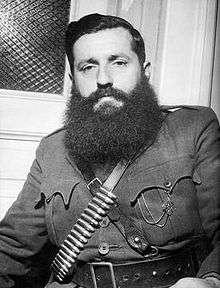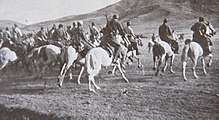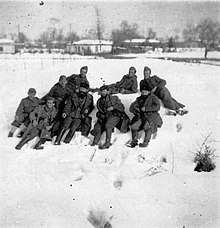Aris Velouchiotis
Athanasios Klaras (Greek: Αθανάσιος Κλάρας; August 27, 1905 – June 16, 1945), better known by the nom de guerre Aris Velouchiotis (Greek: Άρης Βελουχιώτης), was the most prominent leader and chief instigator of the Greek People's Liberation Army (ELAS), the military branch of the National Liberation Front (EAM), which was the major resistance organization in occupied Greece from 1942 to 1945.
Aris Velouchiotis | |
|---|---|
 Velouchiotis in Athens after the Liberation (Hotel Grand Bretagne, photo by Dmitri Kessel) | |
| Born | Athanasios Klaras August 27, 1905 |
| Died | June 16, 1945 (aged 39) |
| Organization | National Liberation Front Greek People's Liberation Army |
| Political party | Communist Party of Greece |
Early years
Aris Velouchiotis was born in Lamia, Greece in 1905, to an upper urban class family. His father was Dimitrios Klaras, a well-known lawyer in the area and his mother was Aglaia Zerva. Initially Klaras studied journalism, but later attended and graduated from the Geoponic School of Larissa. He left for Athens, where he did various jobs, participated in the leftist and antimilitary movement and later became a member of the Communist Party of Greece (KKE). During the 1920s and 30s he was jailed several times for different offenses.
He became an editor in the communist Rizospastis and wrote several articles for the socialist revolution. In 1931, an article of Klaras caused the intervention of the authorities, who closed the newspaper and proceed at trial the editors. The newspaper was republished as Neos Rizospastis.
From a letter of Klaras to Rizospastis, 1931
During the Ioannis Metaxas dictatorship (1936–1941), he was arrested for his communist ideas and jailed in the Aegina prison, where he was tortured. However, during his trial he managed to escape but was arrested again in 1939 and sent to a prison in Corfu. He remained imprisoned there until signing a "statement of renouncement of KKE and of the communist ideology", a very humiliating act for a communist at the time.
World War II: From Klaras to Aris


During World War II, he fought as an artillery private of the Hellenic Army at the Albanian front against the Italian army, until the German invasion in April 1941 and Greece's subsequent surrender and occupation.
After Germany's offensive campaign in the Soviet Union, the Greek Communist Party championed the creation of the National Liberation Front (EAM), and Klaras was sent to Central Greece (Greek Roumeli) to assess the potential for the development of a guerrilla movement against the occupation forces in this area. His proposals were adopted by the party, and in January 1942, Klaras moved to the mountains to start setting up guerrilla groups.
The first appearance of the partisans organised by Klaras occurred on June 7, 1942 in the village of Domnista in Evrytania in Central Greece. There he presented himself as Major of Artillery (for gaining extra prestige among the villagers) with the nom de guerre of Aris Velouchiotis (from Ares, the Greek god of war, and Velouchi, a local mountain) and proclaimed the existence of the Greek People's Liberation Army (ELAS). Initially, he collected also the traditional local mountain living bandits in order to create a small group of experts in guerrilla fighting. Velouchiotis as a leader applied steely discipline and managed to have under his commands a considerable number of guerillas. Starting with only 15 men, ELAS' power finally comprised up to 50,000 guerillas.
One of the most important early operations of the Greek resistance movement (in which Velouchiotis and his fighters, after negotiations with the British, agreed to participate alongside Napoleon Zervas's republican EDES resistance forces and twelve British saboteurs under the leadership of Major E. C. W. "Eddie" Myers) was the blowing-up of the Gorgopotamos railway viaduct, south of Lamia, on November 25, 1942 (Operation Harling). The destruction of the viaduct cut the single Thessaloniki-Athens rail line, thus the line connecting the Balkans with southern Greece, but did not disrupt any supply lines—as would have been the case had it happened, as the British intended, two months earlier—to Erwin Rommel's German forces in Northern Africa, as it took place one month after the commencement of the El Alamein battle on October 23, 1942, in which Rommel was badly defeated by the British.
The destruction of the Gorgopotamos viaduct was to be the last operation where the communist-influenced ELAS organisation fought alongside Greek Republican resistance forces, such as the EKKA's 5/42 Evzones Regiment (military arm of EKKA) and EOEA (National Groups of Greek Guerillas, Εthnikes Omades Ellinon Antarton, military arm of EDES). But despite the signing of an agreement in July 1943 between the three main Resistance groups (EAM/ELAS, EDES and EKKA) to cooperate and to subject themselves to the Allied Middle East High Command under General Wilson (the "National Bands Agreement"), in the political field, the mutual mistrust between EAM and the other groups escalated. EAM-ELAS was by now the dominant political and military force in Greece, and EDES and EKKA, along with the British and the Greek government-in-exile, feared that after the inevitable German withdrawal, it would try to dominate the country and establish a soviet regime The rift ultimately led to a civil war in late 1943 and early 1944, in which ELAS attacked EDES, EOEA and destroyed EKKA's 5/42 Evzones Regiment, executing its leader Col. Dimitrios Psarros.
Liberation and expulsion from the Communist Party

In October 1944, when the Nazis evacuated Greece, ELAS was the dominant force in most of the Greek cities, except Athens, while EAM had established its own government, the PEEA.
Velouchiotis passed from Central Greece to Peloponnese to clear the region from the Security Battalions, and gave several battles against them.
The British, with units of the Greek Army, were landed in Greece (Operation Manna) and a new government was formed under Georgios Papandreou, the leader of the Greek National Unity Government, which was established following the Treaties of Lebanon and Caserta. Velouchiotis returned to Central Greece and made a speech in his native town, Lamia.
From Velouchiotis speech in Lamia[1]
During the Dekemvriana events in Athens, he was sent by the Party to Epirus, where he attacked the forces of Zervas' EDES. EDES evacuated the region of Epirus and passed to the Ionian islands.
When the Varkiza agreement was signed to end the Dekemvriana fighting between EAM forces and governmental/British forces in Athens, he personally with General Sarafis signed the demobilisation of the ELAS army. But afterwards, he vehemently refused to comply regarding the agreement as a betrayal of the guerillas.
The leadership of the Communist Party, under Nikos Zachariadis, consequently accused him of treachery, of being a "suspicious and adventurous element" and spurned him as a member of KKE .[2][3] The Communist Party was always suspicious of Klaras' actions since he was a simple member, and even when he founded ELAS, partly cause of his old renouncement of the party and his fickle character.
Death
Velouchiotis moved again to the mountains of Central Greece in order to start an insurgency (see Greek Civil War) against the new government and the British allies who supported them (considering them worse than Germans). He was reported to have denounced the sell-out to the British in the Varkiza Agreement to lay down the National Resistance arms; particularly moving was the sight of his elite massed Mavroskoufides (Black Berets) openly mourning. He was outmanoeuvred by the KKE leadership and resolved to leave Greece; he repeatedly requested permission from the party to be allowed to depart, but was refused.
His intention was to create a new ELAS and a National Independence Front (MEA). Though most of his associates abandoned him, he was reported to have continued to conduct guerrilla activities until June 1945. He was denounced by the KKE Central Committee and increasingly isolated, until he was ambushed with his unit in the mountain of Agrafa (some say that he was set up or even betrayed by KKE contacts) by para-military groups controlled by the Athens government. Aris and his second in command, Giannis Aggeletos (nom de guerre: Leon Tzavellas), were isolated by the main unit and finally he committed suicide with his comrade, either by a hand grenade or by a bullet, on the same day he learned that he was denounced by the communist party.
Rumors want him to "have committed suicide with his commander Tzavellas when his thoughts were that there is no better future for his revolution".[4]

The corpses of Velouchiotis and Tzavellas were subsequently decapitated, and the heads displayed (a practice of the pre-war Greek State and Police for the common mountain bandits), hanging from a lamp post in the central square of the town of Trikala.
When British Labour government members of Parliament objected to the barbarity of the operation, they received the reply that the display was in accordance to an "ancient Greek war custom".
Following the rehabilitation in Greece of the EAM/ELAS and subsequently of the Communist party itself (after the end of the Greek military junta), busts and statues of Aris Velouchiotis have been erected in his native town; recently the KKE moved discreetly for Velouchiotis' rehabilitation, following in turn the expulsion of the KKE's wartime leader (who had denounced him), Nikos Zachariadis.
Relationship with Zervas
Coincidently, the two leaders of the Greek Resistance were distant cousins. Zervas was descendant from the famous Souliote clan of Zervades, who after the destruction of Souli by the Ottomans fled to Aitoloakarnania, while Klaras' mother was of Souliote descent, from a family related to Zervades. However, Zervas had never before seen Velouchiotis before their first meeting during the Resistance era.
Legacy
Velouchiotis is one of the most controversial figures of modern Greek history. His personality and action was mythologised during his life and after his death. Supporters consider him a symbol of Greek resistance against the occupying powers, the founder and creator of the biggest guerrilla army in the Greek history (ELAS) and a hero of the communist cause. Critics see him as a perpetrator of atrocities and murders against rural people who were perceived as opponents of communism; a basic instigator of the Red Terror.[5] In his memories he appreciates his military abilities. However, he was a man of strong patriotic beliefs. He was especially strict to Greeks who sought collaboration with the occupying forces, with his companions who broke the organized discipline, and people who approved the involvement of the British in Greek politics since he considered the British a threat to the patriotic cause of the Resistance.[6]
See also
Notes
- The last speech of Velouchiotis
- ΚΚΕ, επίσημα κείμενα, τ8
- Δοκίμιο Ιστορίας του ΚΚΕ
- For a complete presentation of the circumstances of Velouchiotis' death see: Χαριτόπουλος, Διονύσης (Charitopoulos, Dionysis) (2003). Άρης, ο Αρχηγός των Ατάκτων (Aris, the Leader of the Rebels). Athens: Ελληνικά Γράμματα (Ellinika Grammata), 565-571. Charitopoulos takes for granted that Velouchiotis committed a "heroic" suicide.
- C.M. Woodhouse, "The Struggle for Greece, 1941-1949", ISBN 1-85065-487-5, pp. 4-5.
- Papastratis, Prokopis (1984). British policy towards Greece during the Second World War, 1941–1944. Cambridge University Press. ISBN 978-0-521-24342-1.
Further reading
- Χαριτόπουλος, Διονύσης (Charitopoulos, Dionysis) (2009). Άρης, ο Αρχηγός των Ατάκτων (Aris, the Leader of the Irregulars) (3rd ed.). Athens: Τόπος (Topos). ISBN 960-406-538-6.CS1 maint: multiple names: authors list (link) Extensive biography in Greek, published also in English in 2012 by the same publisher as "Aris, Lord of the Mountains"